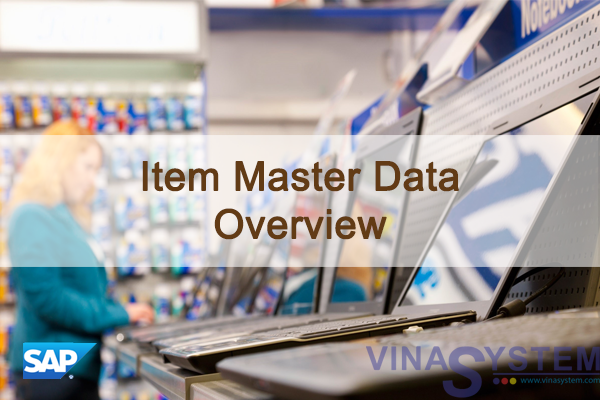
Tài liệu về danh mục hàng hóa trong SAP Business One - Item Master Data
At the end of this topic, you will be able to:
- Describe the contents of the item master
Your company has a large number of items. To better manage the needs of daily business, items are set up as master data records. Default data for purchasing, sales and inventory transactions are contained in item master records.
I/ Item Master Data: Overview

- SAP Business One enables you to manage all the items that you purchase, manufacture, sell, or keep in stock.
- The way we define what these items are and how they are handled is through the item master data record.
- An item master data record is created for each product and identified with a unique code. You would create an item master for a product at the level of a universal product code or a catalog number.
- Item master data is at the heart of almost every process in SAP Business One. It controls how the item acts in the sales, purchasing, production, MRP, inventory, and service modules.
- An item master data record stores essential information such as if the item is purchased or sold, the price of the item, the inventory level, and how purchasing of the item is forecast and planned.
- This data is used automatically by the system in the processes for purchasing, sales, production, managing your warehouse, and accounting.

- One important rule applies to item master data. If a master data record is used in a marketing document or in an accounting or inventory transaction (such as an A/P invoice, A/R Invoice, Journal Entry and so on), it cannot be deleted.
- But what about obsolete items? Perhaps you no longer wish to sell a particular model of monitor, but since it has been stocked and sold in the past you cannot delete it.
- What can you do?
- Instead you can mark the item as inactive so it can no longer be added to sales orders. The inactive checkbox can also be used for products that are not yet ready for sales and purchasing transactions.
- You can choose to exclude these inactive items from system reports. Later on, when you archive old data and these items no longer have transactions related to them in the database, it is possible to delete them completely.
II/ Structure of the Item Master Record:

- Like other types of master data, such as the business partner, there are two main sections in an item master record: the header and the tabs.
- The header contains general information about the item. A unique ID number must be assigned as the code.
- The tabs contain more detailed contain information for processing the item.
III/ Item Categories

- The header is also where you can assign item categories. The item categories control whether that item can be purchased, sold, or stored in inventory. An item can belong to multiple categories.
- Designating the item as an inventory item means that the item can be used in inventory transactions.
- Similarly marking an item for purchasing or sales means that the item can be bought or sold on marketing documents.
- If you mark an item as inventory only, you cannot buy or sell that item.
- Perhaps you have an item that you never purchase, instead you manufacture the item in-house and then sell it. This item would be marked for inventory and sales.
- A second example would be a service that you sell. In this case, the item would be marked only for sales, and not for purchasing or inventory.
- A third example could be expenditures, like office supplies, that you purchase for use in your business. You might choose not receive these into inventory because they are used directly after purchase. This item then would be a purchased item but not an inventory item.
IV/ Purchasing and Sales tabs

- The purchasing data and sales data tabs contain the information necessary for using that item on marketing documents.
- The sales data tab contains information on the item’s sales units of measure, sales item dimensions, packaging for sales, and tax details.
- Similarly, the purchasing data tab contains information on the item’s purchasing unit of measure with its dimensions, packaging and tax details.
- Additionally, the purchasing data tab has information about specific vendors and manufacturer catalog numbers.
- When you create a marketing document, the relevant information for the item defaults into the document.
- Both tabs offer you a link to reporting via icons for Sales Analysis and Purchase Analysis for the item.
V/ Inventory Data tab and Stock Levels

- The inventory data tab shows us up-to-date information on stock levels and demand for the item for each warehouse. This information is updated dynamically so shows a true picture at any time.
- A matrix displays:
- The quantity currently in stock
- The committed quantity, which is the quantity ordered by customers
- The ordered quantity, which represents either quantity ordered for purchase by your company but not yet delivered or the quantity on production orders for an item produced in-house
- And in the last column, it displays each the quantity available for sales orders. The available quantity is calculated by adding together the in stock and ordered quantities then subtracting any committed quantity.
- You can set a warehouse to be the default warehouse for transactions. If you do not set a default, the first one appearing in the matrix will be the default.
- Other fields on this tab page, such as the valuation method and inventory unit of measure are discussed more in later topics.
VI/ Planning Data

- The planning tab contains information for planning your inventory requirements.
- On this tab, you can control whether the item is considered in material requirement planning.
- And if it is relevant for planning you can indicate whether this is an item that is purchased or built in-house and set a lead time for calculating how long it will take to restock the item. The other fields on this tab support the materials requirement planning process.
VII/ Item Properties

- Item properties give you a way to add more information about how this item fits into your company lines of business, sales territories and marketing goals.
- On this tab you can classify the item with up to 64 different properties which you can use for reporting, marketing purposes and even for determining pricing.
- For example, a particular laptop might be classified according to the type of user (professional, student), condition (new, refurbished), and other properties such as screen size, processor brand, price range, system memory, touchscreen or not, operating platform, and much more.
VIII/ Summary
Here are some key points:
- Item Master Data controls how an item acts in business processes. The data is used automatically in processes for purchasing, sales, production, warehouse management, service and accounting.
- A master data record used in transactions cannot be deleted, but it can be marked inactive.
- Item categories control whether an item can be purchased, sold or stored in inventory. An item can belong to multiple categories.
- The inventory data tab tracks the in-stock, committed, ordered, and available quantities for an inventory item.
- Available quantity = in-stock + ordered – committed.






